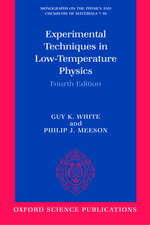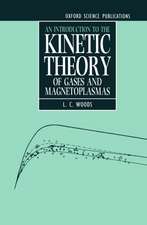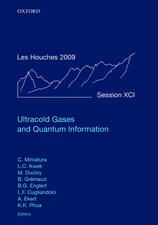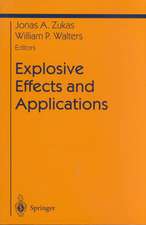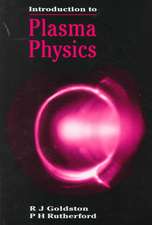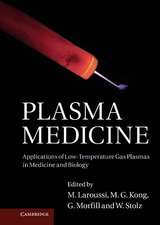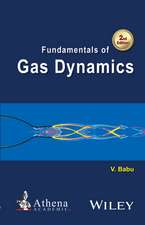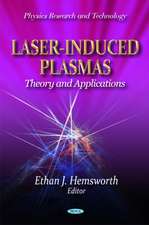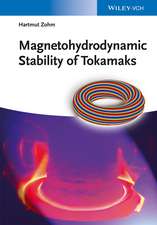Magnetic Control of Tokamak Plasmas: Advances in Industrial Control
Autor Marco Ariola, Alfredo Pirontien Limba Engleză Paperback – 7 apr 2018
The second edition of Magnetic Control of Tokamak Plasmas contains numerous updates and a substantial amount of completely new material covering areas such as:
• modelling and control of resistive wall modes—the most important non-axisimmetric mode;
• the isoflux approach for shape control;
• a general approach for the control of limiter plasmas;
• the use of inner vessel coils for vertical stabilization; and
• significantly enhanced treatment of plasma-shape control at JET, including experimental results and introducing a method implemented for operation in the presence of current saturations.
Whenever possible, coverage of the various topics is rounded out with experimental results obtained on currently existing tokamaks. The book also includes a presentation of the typical actuators and sensors used for control purposes in tokamaks. Some mathematical details are given in the appendices for the interested reader.
The ideas formulated in this monograph will be of great practical help to control engineers, academic researchers and graduate students working directly with problems related to the control of nuclear fusion. They will also stimulate control researchers interested more generally in the advanced applications of the discipline.
Advances in Industrial Control aims to report and encourage the transfer of technology in control engineering. The rapid development of control technology has an impact on all areas of the control discipline. The series offers an opportunity for researchers to present an extended exposition of new work in all aspects of industrial control.
| Toate formatele și edițiile | Preț | Express |
|---|---|---|
| Paperback (2) | 777.50 lei 6-8 săpt. | |
| Springer International Publishing – 7 apr 2018 | 777.50 lei 6-8 săpt. | |
| SPRINGER LONDON – 21 oct 2010 | 830.24 lei 6-8 săpt. | |
| Hardback (1) | 783.50 lei 6-8 săpt. | |
| Springer International Publishing – 2 mar 2016 | 783.50 lei 6-8 săpt. |
Din seria Advances in Industrial Control
- 15%
 Preț: 643.34 lei
Preț: 643.34 lei - 23%
 Preț: 582.63 lei
Preț: 582.63 lei - 18%
 Preț: 783.98 lei
Preț: 783.98 lei - 18%
 Preț: 947.35 lei
Preț: 947.35 lei - 20%
 Preț: 568.24 lei
Preț: 568.24 lei - 15%
 Preț: 643.16 lei
Preț: 643.16 lei - 18%
 Preț: 899.21 lei
Preț: 899.21 lei - 18%
 Preț: 891.33 lei
Preț: 891.33 lei - 18%
 Preț: 740.57 lei
Preț: 740.57 lei - 18%
 Preț: 961.23 lei
Preț: 961.23 lei - 18%
 Preț: 955.08 lei
Preț: 955.08 lei - 15%
 Preț: 645.28 lei
Preț: 645.28 lei - 15%
 Preț: 638.43 lei
Preț: 638.43 lei - 18%
 Preț: 901.11 lei
Preț: 901.11 lei - 18%
 Preț: 1410.94 lei
Preț: 1410.94 lei - 18%
 Preț: 728.91 lei
Preț: 728.91 lei - 20%
 Preț: 1003.78 lei
Preț: 1003.78 lei - 18%
 Preț: 947.35 lei
Preț: 947.35 lei - 15%
 Preț: 643.34 lei
Preț: 643.34 lei - 15%
 Preț: 654.30 lei
Preț: 654.30 lei - 18%
 Preț: 950.52 lei
Preț: 950.52 lei - 15%
 Preț: 644.30 lei
Preț: 644.30 lei - 18%
 Preț: 1393.09 lei
Preț: 1393.09 lei - 18%
 Preț: 950.21 lei
Preț: 950.21 lei - 18%
 Preț: 949.90 lei
Preț: 949.90 lei - 18%
 Preț: 949.42 lei
Preț: 949.42 lei - 18%
 Preț: 950.52 lei
Preț: 950.52 lei - 18%
 Preț: 1113.71 lei
Preț: 1113.71 lei - 15%
 Preț: 650.04 lei
Preț: 650.04 lei - 15%
 Preț: 644.95 lei
Preț: 644.95 lei - 18%
 Preț: 950.33 lei
Preț: 950.33 lei - 18%
 Preț: 948.61 lei
Preț: 948.61 lei - 18%
 Preț: 1112.60 lei
Preț: 1112.60 lei - 15%
 Preț: 644.63 lei
Preț: 644.63 lei - 18%
 Preț: 953.20 lei
Preț: 953.20 lei - 18%
 Preț: 945.62 lei
Preț: 945.62 lei - 15%
 Preț: 640.88 lei
Preț: 640.88 lei - 15%
 Preț: 640.88 lei
Preț: 640.88 lei - 20%
 Preț: 650.92 lei
Preț: 650.92 lei - 18%
 Preț: 1112.60 lei
Preț: 1112.60 lei - 20%
 Preț: 998.36 lei
Preț: 998.36 lei - 15%
 Preț: 643.34 lei
Preț: 643.34 lei - 18%
 Preț: 948.92 lei
Preț: 948.92 lei - 18%
 Preț: 1381.43 lei
Preț: 1381.43 lei - 15%
 Preț: 651.51 lei
Preț: 651.51 lei - 15%
 Preț: 647.08 lei
Preț: 647.08 lei - 20%
 Preț: 563.66 lei
Preț: 563.66 lei - 18%
 Preț: 992.64 lei
Preț: 992.64 lei - 18%
 Preț: 1225.79 lei
Preț: 1225.79 lei
Preț: 777.50 lei
Preț vechi: 948.18 lei
-18% Nou
Puncte Express: 1166
Preț estimativ în valută:
148.79€ • 161.57$ • 124.99£
148.79€ • 161.57$ • 124.99£
Carte tipărită la comandă
Livrare economică 22 aprilie-06 mai
Preluare comenzi: 021 569.72.76
Specificații
ISBN-13: 9783319806792
ISBN-10: 3319806793
Ilustrații: XV, 203 p. 78 illus., 67 illus. in color.
Dimensiuni: 155 x 235 mm
Greutate: 0.31 kg
Ediția:Softcover reprint of the original 2nd ed. 2016
Editura: Springer International Publishing
Colecția Springer
Seria Advances in Industrial Control
Locul publicării:Cham, Switzerland
ISBN-10: 3319806793
Ilustrații: XV, 203 p. 78 illus., 67 illus. in color.
Dimensiuni: 155 x 235 mm
Greutate: 0.31 kg
Ediția:Softcover reprint of the original 2nd ed. 2016
Editura: Springer International Publishing
Colecția Springer
Seria Advances in Industrial Control
Locul publicării:Cham, Switzerland
Cuprins
Introduction.- Part I Plasma Modelling.- Plasma Modelling for Magnetic Control.- Modelling of Resistive Wall Modes.- The Plasma Boundary and Its Identification.- Part II Plasma Control.- Plasma Magnetic Control Problem.- Plasma Position and Current Control for Limiter Plasmas.- Plasma Vertical Stabilization.- Plasma Shape Control for ITER.- Plasma Shape Control at TCV.- Plasma Shape Control at JET.- Control of Resistive Wall Modes.- Appendices: Some Mathematical Background; Units Used in Plasma Physics.
Notă biografică
Marco Ariola was born in Naples, Italy, in 1971. He received the Laurea degree in electronic engineering and the Research Doctorate degree in electronic engineering and computer science from the University of Naples Federico II, Naples, Italy, in 1995 and 2000, respectively. From 1996 to 2005 he was with the Department of Computer and Systems Engineering of the University of Naples Federico II. Currently, he is a full Professor of Automatic Control at the University of Naples Parthenope in the Engineering Department. From September 1998 to February 1999, he was a Visiting Scholar with the Department of Electrical & Computer Engineering of University of New Mexico, Albuquerque, NM, USA. His research interests include statistical control, robust control, control of nuclear fusion devices, control of aerospace systems. He has published more than 150 journal papers, conference papers, articles in books and encyclopedias. He is co-author of the books “Magnetic Control of Tokamak Plasmas” and “Finite-Time Stability and Control” published by Springer in 2008 and 2013. He is a senior member of the IEEE.
Professor AlfredoPironti received the Laurea degree cum Laude in Electronic Engineering, and thePhD in Electronic and Computing Engineering from the University of NaplesFederico II in 1991 and 1995, respectively. Since 1991 he works at theUniversity of Naples Federico II, where he currently is a Full Professor ofSystem and Control Theory in the Department of Electrical and InformationTechnology Engineering. He has spent several periods as visiting researcher atthe Max Planck Institute for Plasma Physics in Garching (Germany), the Centerfor Control Engineering and Computation (University of California at SantaBarbara), the ITER Joint Work Site of Naka (Japan), and the EFDA-JET site ofCulham (UK). His research interests include application of feedback control tonuclear fusion problems, robust control of uncertain systems, and differentialgames theory. In 2005 Alfredo Pironti has been guest editor for the IEEEControl Systems Magazine journal, where he has contributed to two specialissues focused on the control of plasmas in tokamak machines. In 2008 he hasco-authored the book "Magnetic Control of Tokamak Plasmas" publishedby Springer. He contributes to the IEEE CSS Technical Committee on PowerGeneration, co-chairing the thrust on Nuclear Energy Generation. He is authorof more than 200 papers published on international journals, books, andconference proceedings.
Professor AlfredoPironti received the Laurea degree cum Laude in Electronic Engineering, and thePhD in Electronic and Computing Engineering from the University of NaplesFederico II in 1991 and 1995, respectively. Since 1991 he works at theUniversity of Naples Federico II, where he currently is a Full Professor ofSystem and Control Theory in the Department of Electrical and InformationTechnology Engineering. He has spent several periods as visiting researcher atthe Max Planck Institute for Plasma Physics in Garching (Germany), the Centerfor Control Engineering and Computation (University of California at SantaBarbara), the ITER Joint Work Site of Naka (Japan), and the EFDA-JET site ofCulham (UK). His research interests include application of feedback control tonuclear fusion problems, robust control of uncertain systems, and differentialgames theory. In 2005 Alfredo Pironti has been guest editor for the IEEEControl Systems Magazine journal, where he has contributed to two specialissues focused on the control of plasmas in tokamak machines. In 2008 he hasco-authored the book "Magnetic Control of Tokamak Plasmas" publishedby Springer. He contributes to the IEEE CSS Technical Committee on PowerGeneration, co-chairing the thrust on Nuclear Energy Generation. He is authorof more than 200 papers published on international journals, books, andconference proceedings.
Textul de pe ultima copertă
This book is a complete treatment of work done to resolve the problems of position-, current-, and shape-control of plasma in tokamak-type (toroidal) devices being studied as a potential means of commercial energy production by nuclear fusion. Modelling and control are both detailed, allowing non-expert readers to understand the control problem. Starting from the magneto-hydro-dynamic equations, all the steps needed for the derivation of plasma state-space models are enumerated with frequent recall of the basic concepts of electromagnetics. The control problem is then described, beginning with the control of current and position—vertical and radial—control and progressing to the more challenging shape control. The solutions proposed vary from simple PIDs to more sophisticated MIMO controllers.
The second edition of Magnetic Control of Tokamak Plasmas contains numerous updates and a substantial amount of completely new material covering areas such as:
Whenever possible, coverage of the various topics is rounded out with experimental results obtained on currently existing tokamaks. The book also includes a presentation of the typical actuators and sensors used for control purposes in tokamaks. Some mathematical details are given in the appendices for the interested reader.
The ideas formulated in this monograph will be of great practical help to control engineers, academic researchers and graduate students working directly with problems related to the control of nuclear fusion. They will also stimulate control researchers interested more generally in the advanced applications of the discipline.
Advances in Industrial Control aims to report and encourage the transfer of technology in control engineering. The rapid development of control technology has an impact on all areas of the control discipline. The series offers an opportunity for researchers to present an extended exposition of new work in all aspects of industrial control.
The second edition of Magnetic Control of Tokamak Plasmas contains numerous updates and a substantial amount of completely new material covering areas such as:
- modelling and control of resistive wall modes—the most important non-axisimmetric mode;
- the isoflux approach for shape control;
- a general approach for the control of limiter plasmas;
- the use of inner vessel coils for vertical stabilization; and
- significantly enhanced treatment of plasma-shape control at JET, including experimental results and introducing a method implemented for operation in the presence of current saturations.
Whenever possible, coverage of the various topics is rounded out with experimental results obtained on currently existing tokamaks. The book also includes a presentation of the typical actuators and sensors used for control purposes in tokamaks. Some mathematical details are given in the appendices for the interested reader.
The ideas formulated in this monograph will be of great practical help to control engineers, academic researchers and graduate students working directly with problems related to the control of nuclear fusion. They will also stimulate control researchers interested more generally in the advanced applications of the discipline.
Advances in Industrial Control aims to report and encourage the transfer of technology in control engineering. The rapid development of control technology has an impact on all areas of the control discipline. The series offers an opportunity for researchers to present an extended exposition of new work in all aspects of industrial control.
Caracteristici
Enriches understanding of a potentially overwhelmingly important method of energy generation Illustrates the complete process of feedback controller design for magnetic plasma containment – covering both modelling and control Outlines and compares various approaches to plasma shape control Includes supplementary material: sn.pub/extras
Recenzii
From the reviews:
"The book offers a thorough coverage of the magnetic control of plasma in tokamaks. Tokamaks have been proved to be the most promising design for future thermonuclear reactors. … There are also descriptions of tokamaks as devices using control theory concepts. This makes the book accessible for a wide audience of readers–not only for physicists and narrow specialists." (Vyacheslav F. Gubarev, Mathematical Reviews, Issue 2009 h)
“The book presents the main features of plasma modelling and plasma control, focusing on tokamak current and future devices. Throughout two parts and nine chapters of their book, the authors model plasmas, coming back to the theory of magnetohydrodynamics. They illustrate the interest of such plasmas in various configurations. … will be useful to scientists involved in tokamaks and to engineers having in charge the control of such devices.” (Alain Brillard, Zentralblatt MATH, Vol. 1185, 2010)
"The book offers a thorough coverage of the magnetic control of plasma in tokamaks. Tokamaks have been proved to be the most promising design for future thermonuclear reactors. … There are also descriptions of tokamaks as devices using control theory concepts. This makes the book accessible for a wide audience of readers–not only for physicists and narrow specialists." (Vyacheslav F. Gubarev, Mathematical Reviews, Issue 2009 h)
“The book presents the main features of plasma modelling and plasma control, focusing on tokamak current and future devices. Throughout two parts and nine chapters of their book, the authors model plasmas, coming back to the theory of magnetohydrodynamics. They illustrate the interest of such plasmas in various configurations. … will be useful to scientists involved in tokamaks and to engineers having in charge the control of such devices.” (Alain Brillard, Zentralblatt MATH, Vol. 1185, 2010)

